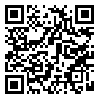Sun, Apr 6, 2025
[Archive]
Volume 14, Issue 44 (2022)
JMED 2022, 14(44): 28-35 |
Back to browse issues page
Ethics code: IR.NKUMS.REC.1400.132
Download citation:
BibTeX | RIS | EndNote | Medlars | ProCite | Reference Manager | RefWorks
Send citation to:



BibTeX | RIS | EndNote | Medlars | ProCite | Reference Manager | RefWorks
Send citation to:
Namdar Ahmadabad H, Abaspour A, Abasi Z, Rashidi Fakari F, Bozorgmehr M. Evaluation of Educational Challenges of General Medicine Students. JMED 2022; 14 (44) :28-35
URL: http://edujournal.zums.ac.ir/article-1-1519-en.html
URL: http://edujournal.zums.ac.ir/article-1-1519-en.html
Hassan Namdar Ahmadabad1 

 , Alireza Abaspour1
, Alireza Abaspour1 

 , Zohreh Abasi2
, Zohreh Abasi2 

 , Farzaneh Rashidi Fakari *3
, Farzaneh Rashidi Fakari *3 

 , Mehrgan Bozorgmehr4
, Mehrgan Bozorgmehr4 




 , Alireza Abaspour1
, Alireza Abaspour1 

 , Zohreh Abasi2
, Zohreh Abasi2 

 , Farzaneh Rashidi Fakari *3
, Farzaneh Rashidi Fakari *3 

 , Mehrgan Bozorgmehr4
, Mehrgan Bozorgmehr4 


1- Department of Pathobiology and Laboratory Sciences, School of Medicine, North Khorasan University of Medical Sciences, Bojnurd, Iran.
2- Department of Midwifery, School of Medicine, North Khorasan University of Medical Sciences, Bojnurd, Iran.
3- Department of Midwifery, School of Medicine, North Khorasan University of Medical Sciences, Bojnurd, Iran. ,rashidiff@yahoo.com
4- School of Medicine, North Khorasan University of Medical Sciences, Bojnurd, Iran.
2- Department of Midwifery, School of Medicine, North Khorasan University of Medical Sciences, Bojnurd, Iran.
3- Department of Midwifery, School of Medicine, North Khorasan University of Medical Sciences, Bojnurd, Iran. ,
4- School of Medicine, North Khorasan University of Medical Sciences, Bojnurd, Iran.
Abstract: (3228 Views)
Background & Objective: Medical education and training efficient human resources have always been among educational planners’ concerns. Given the history of medical education in our country, identification of medical education problems, barriers, and challenges and attempting to eliminate or correct them will increase the chance of achieving educational goals and training expert, capable and efficient people. Therefore, the present study aimed to analyze the educational challenges of general medicine students at North Khorasan University of Medical Sciences.
Materials & Methods: This qualitative study was performed on 15 faculty members, medical students, the head of the medical education department, treatment vice-chancellors, and education and research vice-chancellors using conventional content analysis in 2020. The subjects were selected by purposive sampling.
Results: In this study, the most important educational challenges of medical students were classified into three categories of educational structures, training processes, and underlying components and seven sub-categories of human resources, physical space, equipment, planning, management, evaluation and monitoring, motivational causes and professionalism.
Conclusion: Our findings provided a deeper understanding of the educational challenges of medical students, comprehension of which helps develop the field of medicine and eliminate its barriers.
Materials & Methods: This qualitative study was performed on 15 faculty members, medical students, the head of the medical education department, treatment vice-chancellors, and education and research vice-chancellors using conventional content analysis in 2020. The subjects were selected by purposive sampling.
Results: In this study, the most important educational challenges of medical students were classified into three categories of educational structures, training processes, and underlying components and seven sub-categories of human resources, physical space, equipment, planning, management, evaluation and monitoring, motivational causes and professionalism.
Conclusion: Our findings provided a deeper understanding of the educational challenges of medical students, comprehension of which helps develop the field of medicine and eliminate its barriers.
Article Type : Orginal Research |
Received: 2021/11/30 | Accepted: 2022/02/24 | Published: 2022/03/14
Received: 2021/11/30 | Accepted: 2022/02/24 | Published: 2022/03/14
Send email to the article author
| Rights and permissions | |
 |
This work is licensed under a Creative Commons Attribution-NonCommercial 4.0 International License. |


